 Image search results - "meiji" Image search results - "meiji" |

Entrance to Chomeiji Temple. MAP
|
|
|

808 steps to Chomeiji. Chomeiji (Long Life Temple) worships the Kannon goddess dedicated to long life and good health. It belongs to the Tendai Buddhist sect.
|
|
|
|
|
|
|

Halfway point and rest stop
|
|
|
|
|
|

The steps never seem to end...
|
|

For people with cars, drive almost to the top
|
|

Top in sight
|
|

Gate to temple, at lastTook me over 20 min. to climb the 808 steps.
|
|

Water fountain
|
|

Last flight of steps
|
|

Stone lantern sculpture
|
|

Verse 6 Lyrics (Chomeiji) 六番の英訳(長命寺)Saigoku pilgrimage, Chomeiji.
Dispel this world's impureness, very faraway.
Golden waves on which we weave, rowing all we can.
Tell us my friends your stories, with your fervent hearts.
西国十番 長命寺
汚れの現世 遠く去りて
黄金の波に いざ漕がん
語れ我が友 熱き心
Saigoku Juban, Chomeiji
Kegare no utsushiyo, tooku sarite
Kogane no nami ni, iza kogan
Katare wagatomo, atsuki kokoro
--
This verse is said to refer to the Pure Land of Buddhism. The song has strong Buddhist overtones, but interestingly the melody happens to be based on a Christian hymn. Chomeiji was a lunch stop before they rowed back to Otsu.
See more photos of Chomeiji Temple here.
|
|

"Saigoku pilgrimage, Chomeiji."
|
|

Chomeiji, 31st temple on the Saigoku Pilgrimage Circuit
|
|
|

"Dispel this world's impureness, very faraway."
|
|

3-story pagodaThis is what you first see at the top.
|
|

Stone monument for Verse 6
|
|

Hondo main hall and pagoda 本堂
|
|
|

HondoPilgrims often come and chant.
|
|

Hondo altar
|
|

Hondo altar
|
|

Hondo altar
|
|

Ema prayer tablet for Chomeiji
|
|

Hondo 本堂
|
|

Hondo
|
|
|
|
|
|
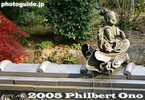
Roof ornament
|
|
|

護摩堂
|
|
|
|

3-story pagoda 三重塔Important Cultural Property
|
|
|
|
|
|

納礼堂
|
|
|

Temple grounds
|
|

View of Lake Biwa
|
|

Chomeiji is also part of the Lake Biwa Japan Heritage.
|
|

On the way to the main temple is this song monument for Biwako Shuko no Uta (Lake Biwa Rowing Song).
|
|

The Biwako Shuko no Uta song monument is engraved with the song's Verse 6 that mentions Chomeiji.
|
|

With the pagoda in the background, the song monument can be seen on the lower right.
|
|

三仏堂
|
|

三仏堂
|
|

三仏堂
|
|
|
|

Bell tower 鐘楼
|
|

Bell tower
|
|
|
|
|
|

Inside the bell tower. Admission is free, but a small donation is requested to ring the bell.
|
|

You have to go up the steps to ring the temple bell.
|
|

Bell ringer log and rope.
|
|

Temple bell.
|
|

如法行堂
|
|
|

As seen from the bell tower
|
|
|

Chomeiji roofs
|
|

大権現社
|
|
|
|

Giant rock
|
|
|
|

天尊堂
|
|

Stairs back down
|
|

Lake Biwa Rowing Song (Biwako Shuko no Uta) monument 琵琶湖就航の歌 歌碑The song is about a four-day, boat-rowing trip around Lake Biwa undertaken on June 27, 1917 by seven college students. They were in the rowing club at an elite college in Kyoto called Dai-san Koto Gakko (No. 3 High School 第三高等学校) which later merged with Kyoto University. They started at Otsu and rowed to Omatsu (now called Omi-Maiko), Imazu, Chikubushima island, Nagahama, Hikone, Chomeiji, and back to Otsu. They stopped overnight at Omatsu, Imazu, and Hikone.
For a detailed explanation of this song and monument, this album.
Biwako Shuko no Uta
|
|

Lake Biwa Rowing Song (Biwako Shuko no Uta) monument 琵琶湖就航の歌 歌碑
|
|

Lake Biwa Rowing Song (Biwako Shuko no Uta) monument for Verse 6 琵琶湖就航の歌 歌碑
|
|
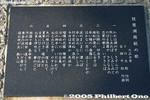
Lake Biwa Rowing Song (Biwako Shuko no Uta) monument 琵琶湖就航の歌 歌碑
|
|

Chomeiji pier
|
|

Chomeiji bus stop
|
|

Meiji Shrine or Meiji Jingu is Tokyo largest and most important Shinto shrine. Dedicated to Emperor Meiji (1852–1912) and Empress Shoken (1849–1914). The most popular shrine during New Year's in Tokyo. It also holds a variety of seasonal events.
|
|

JR Harajuku Station will soon be replaced by a new building.
|
|

Harajuku Station
|
|

Meiji Shrine is one of Tokyo's major sights. Cross the Bridge over the train tracks.
|
|

The torii gate for Meiji Shrine.
|
|

Meiji Shrine torii
|
|
|
|

Meiji Shrine is in a large wooded, park-like area. A wide walking path leads to the shrine. It can be dusty due to the gravel.
|
|

Meiji Shrine's forest was man-made, not natural.
|
|
|
|
|
|
|
|

Barrels of French wine offered to the Meiji Shrine because the Meiji Emperor liked wine.
|
|
|
|

Across the barrels of wine are barrels of sake rice wine.
|
|

Sake rice wine.
|
|

Turn left and see another torii.
|
|

Go left.
|
|

Second torii
|
|
|

Along here, you may see some outdoor panel displays.
|
|
|
|
|
|
|

Where you wash/purify yourself. Temizuya
|
|

Where you wash/purify yourself. Temizuya
|
|
|

Last torii before the main shrine.
|
|

Shrine shop for talisman.
|
|

Shinmon Gate 神門
|
|
|

Main shrine hall ahead.
|
|
|
|

Meiji Shrine's main worship hall. If you look closely at the wooden pillars, you can see numerous little cuts in the wood made by people throwing coins at the shrine during New Year's.
|
|
|

The main worship hall is flanked by these two large trees.
|
|

The left tree is actually a couple.
|
|

Two wedded tree trunks (楠) coupled by a sacred rope at Meiji Shrine.
|
|

The right tree provides shade for many ema prayer tablets.
|
|

Ema prayer tablets.
|
|

You can buy a prayer tablet and write your wish/hope/prayer on it and hang it here.
|
|
|
|

Meiji Shrine is also popular for holding weddings. On weekends, you can see several couples passing through.
|
|

At Meiji Shrine, a wedding couple is led by a Shinto priests and two shrine maidens.
|
|
|
|
|
|
|
|
|
|
|
|
|
|
|
|
|
|

Shrine maidens (miko)
|
|

Wedding couple on their way to their ceremony inside the shrine.
|
|

Wedding couple on their way to their ceremony inside the shrine with the wedded trees in the foreground.
|
|
|
|
|

Chrysanthemum crest is the symbol of the Imperial family.
|
|
|
|
|
|
|
|
|
|

Amulets, charms, talisman
|
|
|
|

On the left, there is a gate where you can exit and go to the shrine's park area.
|
|

Path to the park area.
|
|
|
|

Entrance to Treasure Museum.
|
|
|
|
|
|
|

Shiseikan Dojo (Martial Arts Training Hall)
|
|
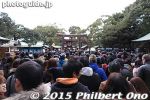
New Year's Day at Meiji Shrine. A total of 3 million people give New Year's prayers (Hatsumode) at Meiji Shrine. Japan's most popular shrine during New Year's.
|
|
|
|
|
|
|
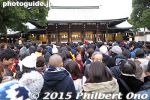
Meiji Shrine on New Year's Day
|
|
|
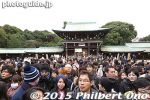
People behind me on New Year's Day at Meiji Shrine.
|
|
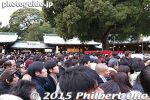
People on my left on New Year's Day at Meiji Shrine.
|
|
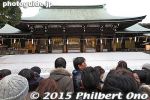
Main worship hall in front and a large offering pit where you throw money, etc.
|
|
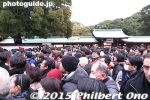
People on my right on New Year's Day at Meiji Shrine.
|
|
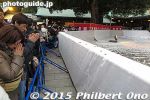
People pray in front of the money/offertory pit.
|
|
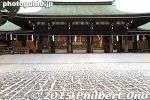
Money in the offertory pit on New Year's Day at Meiji Shrine.
|
|
|

In the past, police were hired to guard the money pit at Meiji Shrine. They also wore these face protectors to deflect the coins that fall short of the pit.
|
|

Lots of coins that fell short of Meiji Shrine's money pit. People no longer throw money from so far away. They wait until they get to the front.
|
|
|

Crowd control and Meiji Shrine.
|
|
|
|
|
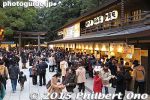
Buying amulets.
|
|
|
|
|
|

Bunkakan museum
|
|

Cafe and restaurant
|
|
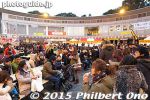
Cafe and restaurant on New Year's.
|
|

Phone booth
|
|
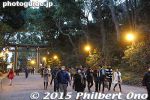
Path back to exit to Harajuku Station.
|
|
|
|
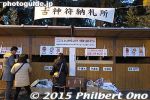
Throw away old New Year's decorations here.
|
|

Spring festival in early May.
|
|

Meiji Shrine's torii.
|
|

Sacred dances performed on stage at Meiji Shrine for their spring festival.
|
|
|
|
|
|
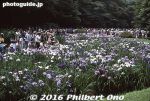
In June, iris garden at Meiji Shrine.
|
|
|
|

On Nov. 3, 2016, went to see Meiji Shrine's annual Autumn Grand Festival (秋の大祭). Nov. 3 is a national holiday called "Culture Day." It's also the late Emperor Meiji's birthday and originally a national holiday for his birthday.
|
|

About the Meiji Shrine's annual Autumn Grand Festival (秋の大祭).
|
|

Entertainment stage on the way to Meiji Shrine.
|
|

A small stage was setup along the main path to Meiji Shrine for traditional performances.
|
|

Sanbaso dancer
|
|

Sanbaso dancer (三番叟) who prays for abundant harvests. Featured in Noh and kabuki as well.
|
|
|
|
|
|
|

Chrysanthemum exhibits on the main path to Meiji Shrine.
|
|

Chrysanthemum exhibits on the main path to Meiji Shrine.
|
|

Chrysanthemum exhibits on the main path to Meiji Shrine.
|
|
|
|
|
|

Meiji Shrine's spanking new torii.
|
|
|
|

The shrine was undergoing major renovations, especially the roof.
|
|
|
|
|

Diplomat cars for foreign ambassadors attending the yabusame horseback archery at Meiji Shrine on Nov. 3.
|
|

Aikido demonstrations
|
|
|

Good thing the weather was good. In fact, Nov. 3 in Japan has a fantastic record for fine weather. It rained on this day only twice or so in the past few decades.
|
|

The main event was yabusame horseback archery.
|
|

Huge crowd. Need to get here early to get a good viewing spot.
|
|

Yabusame is one of Japan's hallmark traditional arts and commonly staged for visiting heads of state at Meiji Shrine.Former US president Ulysses Grant saw it with Emperor Meiji at Ueno Park in 1879, Ronald Reagan in 1983 at Meiji Shrine, George W. Bush (with PM Koizumi) at Meiji Shrine in 2001, and Obama (with Caroline Kennedy) at Meiji Shrine in 2014.
|
|
|
|
|
|
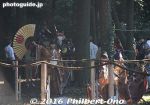
At the start of the horse track, the fan bearer (扇方 ogikata) uses a large fan to signal that the track is clear for the next archer to run.
|
|

It takes about 20 sec. for the horse to complete the run. It's very difficult for the archer to hit all three targets in a single run, but someone usually does it.
|
|

These archers belong to the Takeda School of mounted archery. They are based in Miura, Kanagawa where they practice almost weekly. They have about 60 members.
|
|
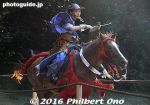
Delighted to see a few women archers too.
|
|

Delighted to see a few women archers at Meiji Shrine yabusame horseback archery on Nov. 3.
|
|

Yabusame is a centuries-old Shinto ceremony to pray for peace in the land and rich harvests. The mounted archery is preceded by a Shinto prayer ceremony. It originated with samurai who had to be skillful mounted archers in medieval battles before guns were introduced.
|
|
|
|